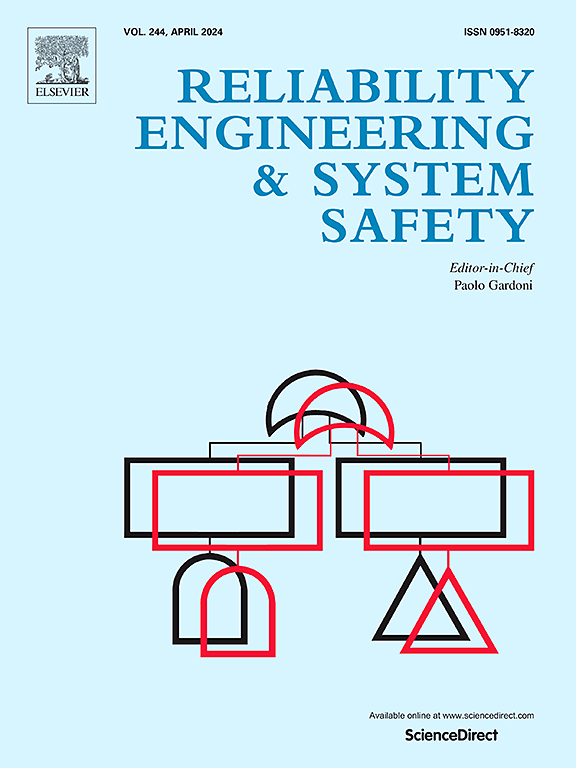Multi-timescale risk-averse restoration for interdependent water–power networks with joint reconfiguration and diverse uncertainties
IF 9.4
1区 工程技术
Q1 ENGINEERING, INDUSTRIAL
引用次数: 0
Abstract
The growing interdependencies between water and power systems have increased the risk of cascading disruptions and widespread blackouts. Such interdependencies, together with different operational characteristics and multiple uncertainties, introduce additional complexities to service restoration. To address these issues, this paper proposes a coordinated multi-timescale restoration strategy for interdependent water–power networks (IWPNs). First, we model the IWPN as network-based with physical mechanisms, incorporating component-wise interdependencies and varying consumer demands. Features comprising pipe damage (water leakage) and storage as well as renewable generations are modelled to better reflect restoration better. Specifically, the joint reconfigurability of water and power networks is first applied for adjustment of topologies and leverages off backup components by coordinated setting of valves and switches. Then, an updated estimation for multiple uncertainties during restoration is utilized, which offers increasing clarity to support better decision-making. These uncertainties arise from renewable generations and water and power demands. A multi-timescale decision framework is developed to capture these effects and tune restoration measures based on response speeds to facilitate efficient and reliable restoration. Finally, the method is implemented by combining robust optimization and risk-averse stochastic programming and applied to a community-scale test system with 25 water nodes and 33 power buses. The proposed method is compared with five conventional methods with numerical results demonstrating the improvements arising from an interdependent restoration, joint reconfigurability, and multi-timescale optimizations.

具有联合重构和多种不确定性的相互依赖水电网络的多时间尺度风险规避恢复
水电系统之间日益增长的相互依赖性增加了连锁中断和大范围停电的风险。这种相互依赖关系,加上不同的操作特征和多种不确定性,给服务恢复带来了额外的复杂性。为了解决这些问题,本文提出了一种相互依赖的水电网络(IWPNs)协调的多时间尺度恢复策略。首先,我们将IWPN建模为基于网络的物理机制,结合组件的相互依赖关系和不同的消费者需求。包括管道损坏(漏水)和储存以及可再生能源在内的特征被建模,以更好地反映修复。具体而言,首先将水电网络的联合可重构性应用于拓扑调整,并通过协调设置阀门和开关来利用备用组件。然后,利用对恢复过程中多个不确定性的更新估计,为更好的决策提供了更清晰的支持。这些不确定性来自于可再生能源以及对水和电力的需求。开发了一个多时间尺度决策框架来捕捉这些影响,并根据响应速度调整恢复措施,以促进有效和可靠的恢复。最后,将鲁棒优化与风险规避随机规划相结合,实现了该方法,并将其应用于具有25个水节点和33个电力母线的社区规模测试系统。将该方法与五种传统方法进行了比较,数值结果表明该方法具有相互依赖恢复、联合可重构性和多时间尺度优化等优点。
本文章由计算机程序翻译,如有差异,请以英文原文为准。
求助全文
约1分钟内获得全文
求助全文
来源期刊

Reliability Engineering & System Safety
管理科学-工程:工业
CiteScore
15.20
自引率
39.50%
发文量
621
审稿时长
67 days
期刊介绍:
Elsevier publishes Reliability Engineering & System Safety in association with the European Safety and Reliability Association and the Safety Engineering and Risk Analysis Division. The international journal is devoted to developing and applying methods to enhance the safety and reliability of complex technological systems, like nuclear power plants, chemical plants, hazardous waste facilities, space systems, offshore and maritime systems, transportation systems, constructed infrastructure, and manufacturing plants. The journal normally publishes only articles that involve the analysis of substantive problems related to the reliability of complex systems or present techniques and/or theoretical results that have a discernable relationship to the solution of such problems. An important aim is to balance academic material and practical applications.
 求助内容:
求助内容: 应助结果提醒方式:
应助结果提醒方式:


